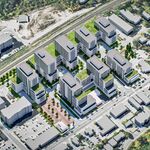afransen
Senior Member
Interesting discussion on elevator regulations in Canada (and US), why they are far more expensive in Canada that much of the rest of the world, and thus there are far fewer elevators per capita. This has a knock-off effect of making small-scale midrise buildings uneconomical.
The policy suggestion is to allow elevators that meet the European/global standard to be used in Canada. This would allow much lower cost elevators, and enable companies that manufacture that standard to make the market in North America more competitive.
The downside is that there are potential concerns around accessibility for wheelchairs, as they are smaller than NA elevators that allow wheelchair users to turn around inside rather than backing in. The argument being that making accessibility requirements so expensive to meet is that it crowds out housing forms that could be more accessible (5-6 story walkups with an elevator) and make it so only townhouses are feasible until high rise can be justified, and townhouses are clearly not very accessibly
On the flip side, I feel like we are not having the right conversations around what accessibility requirements are doing to construction costs and limiting the viability of new development and just generally raising cost of living for everyone. I'm also thinking of the absurd ~20x20' single-occupant accessible washrooms that would make many small establishments infeasible from a cost standpoint.
The policy suggestion is to allow elevators that meet the European/global standard to be used in Canada. This would allow much lower cost elevators, and enable companies that manufacture that standard to make the market in North America more competitive.
The downside is that there are potential concerns around accessibility for wheelchairs, as they are smaller than NA elevators that allow wheelchair users to turn around inside rather than backing in. The argument being that making accessibility requirements so expensive to meet is that it crowds out housing forms that could be more accessible (5-6 story walkups with an elevator) and make it so only townhouses are feasible until high rise can be justified, and townhouses are clearly not very accessibly
On the flip side, I feel like we are not having the right conversations around what accessibility requirements are doing to construction costs and limiting the viability of new development and just generally raising cost of living for everyone. I'm also thinking of the absurd ~20x20' single-occupant accessible washrooms that would make many small establishments infeasible from a cost standpoint.






